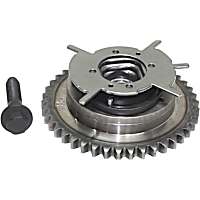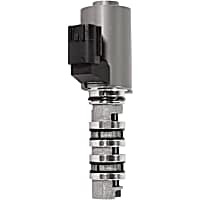Every automaker seems to have a different name for its variable valve timing (VVT) solenoids. Depending on the vehicle manufacturer, these parts may be referred to as camshaft actuator solenoids, oil control solenoids, VANOS solenoids—the list goes on and on.
But despite the different naming conventions, all VVT solenoids do the same thing: apply oil pressure to activate the mechanism that adjusts valve timing. In most cases, that mechanism is an actuator (also known as a phaser) at the end of the camshaft (though some vehicles, such as Hondas with VTEC, may have a different design).
There’s a lot of confusion surrounding VVT solenoid operation, as well as the symptoms associated with a bad VVT solenoid. That’s why we’re here to shed some light on the subject.

Variable Valve Timing Solenoid Symptoms
These days, since most newer vehicles have variable valve timing, VVT solenoid failure is fairly common.
A faulty VVT solenoid can cause several problems. The most common include:
Illuminated Check Engine Light
Your car’s primary computer, which is often referred to as the powertrain control module (PCM), monitors the operation of the VVT solenoid(s). If the PCM detects a problem, it will turn on the check engine light.

Engine Performance Problems
A malfunctioning VVT solenoid can prevent the valve timing from advancing or retarding as needed. As a result, the engine may exhibit performance problems, such as rough running and poor acceleration.
Rattling Noise From the Engine
A faulty VVT solenoid can prevent the VVT actuator from getting the oil pressure it needs. When this happens, you may hear a rattling noise or ticking noise from the engine. Some automakers (e.g. Ford) have technical service bulletins (TSBs) for this concern.

Can You Drive with a Bad VVT Solenoid?
Even though you may technically be able to continue driving with a bad VVT solenoid, the issue can cause damage to additional parts, such as the VVT actuator. So, you should address the issue as soon as possible.
What is a VVT Solenoid?
Before you can understand VVT solenoids, you need to know what variable valve timing (VVT) is. And before you can comprehend VVT, you need to understand how the camshafts and valves work together inside the engine.
So, let’s start with the basics.
How the Camshafts and Valves Work
Inside the engine, there’s a crankshaft and one or more camshafts. The camshafts open and close a series of valves that allow air (and fuel, in the case of port injection) into the engine and exhaust gases out.
Meanwhile, the crankshaft is attached to the connecting rods and pistons.
When the vehicle is running, the valves allow air to enter the engine’s cylinders and mix with fuel. The mixture is ignited by the spark plugs, creating a series of small explosions. Each explosion forces one of the pistons downward inside the engine.
The movement of the pistons makes the crankshaft turn, creating the rotational force needed to propel your vehicle down the road.
A timing chain (or in some cases, a timing belt) connects the crankshaft to the camshafts. The shafts must be kept in sync so that the valves open and close at the correct point in the piston’s travel.
How Variable Valve Timing Works
In a traditional engine, valve timing (when the valves open and close) is fixed. But with a modern, VVT system, the position of the camshaft(s) can be adjusted, thereby altering valve timing. Having this ability can improve engine performance, increase fuel economy, or both.
Several different components work together within a typical VVT system. Most vehicles use a hydraulically-operated actuator located at the end of the camshaft to change the camshaft’s position and retard or advance valve timing.
Our friend, the VVT solenoid, applies oil pressure to activate the actuator. The PCM controls the VVT solenoids based on input from various sensors.
Typically, there’s one VVT solenoid for each actuator. Some vehicles only have an actuator on the exhaust camshaft or the intake camshaft, while others have actuators on both.
It’s worth noting that different automakers have different naming conventions for their VVT systems. For example, Ford refers to its system as Twin Independent Variable Camshaft Timing (Ti-VCT) and BMW calls its setup VANOS.
Where To Find a Quality VVT Solenoid for Your Car
The variable valve timing (VVT) solenoid helps the engine adjust its valve timing to meet the required performance. If the part fails, it might cause engine-related issues like rattling noises, reduced acceleration, and rough running. Fortunately, you can easily get dependable VVT solenoids here at CarParts.com.
CarParts.com makes it easy for you to find a quality VVT solenoid. All you have to do is to enter your vehicle’s details into our vehicle selector. Search the results drawn from our wide selection of parts and get a reliable product that fits your vehicle and budget. Once you place your order, your new parts will ship from the distribution center closest to you so you can get it in as fast as two business days.
Don’t put off getting a replacement for a bad VVT solenoid. Shop now at CarParts.com and get great deals on replacement parts.
Products Mentioned in this Guide
Any information provided on this Website is for informational purposes only and is not intended to replace consultation with a professional mechanic. The accuracy and timeliness of the information may change from the time of publication.


 Cam Phaser
Cam Phaser
 Variable Timing Solenoid
Variable Timing Solenoid



























thanks a lot for your explanation, it was clear and useful for my understanding.
God bess You today.
my car only starts after the manifold heated up